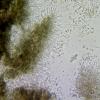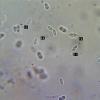
20-12-2025 23:08
Patrice TANCHAUDBonsoir, récolte sur sol sablonneux dans l'arri�

20-12-2025 15:47
Mirek GrycHi.These grew on pine wood that was heavily covere

18-12-2025 21:17
Pol DebaenstThe identification took me to Byssonectria deformi

15-12-2025 07:09
 Danny Newman
Danny Newman
indet. Rutstroemiaceae sp. on unk. fallen leavesMc

19-12-2025 10:10
Patrice TANCHAUDBonjour, récolte réalisée en milieu dunaire, a

18-12-2025 17:23
 Bruno Coué
Bruno Coué
Bonjour,je serais heureux d'avoir votre avis sur c

18-12-2025 18:07
Margot en Geert VullingsThese plumes were found on rotten wood.They strong

17-12-2025 18:35
 Michel Hairaud
Michel Hairaud
Bonjour à tous/Hi to everyone I am passing along
Diaporthe pardalota?
Alan Smith,
14-02-2025 21:55
hello there, this host is a dead stem of Chamerion angustifolium and the fungus could possibly be Diaporthe pardalota due to the stained background and the surrounding black line. However, the spores are too small and are not septate. Could the spores possibly be of the smaller conidial stage which is said to be called Phomopsis convallariae (from fungi.myspecies.info)?
or possibly am I being too ambitious in search of a species!
merci à tous
Alan
Paul Cannon,
17-02-2025 11:40
Re : Diaporthe pardalota?
Yes, this is a Phomopsis, but assigning it to a species is really problematic. Molecular phylogenetic studies suggest that the old morphology-based classification is poor, but there are still many species and there isn't a good broad study that focuses on material on natural substrata. Suggest you simply identify as Phomopsis sp.
Best wishes
Paul
Alan Smith,
19-02-2025 21:26
Re : Diaporthe pardalota?
that's great, thank you Paul
Alan



